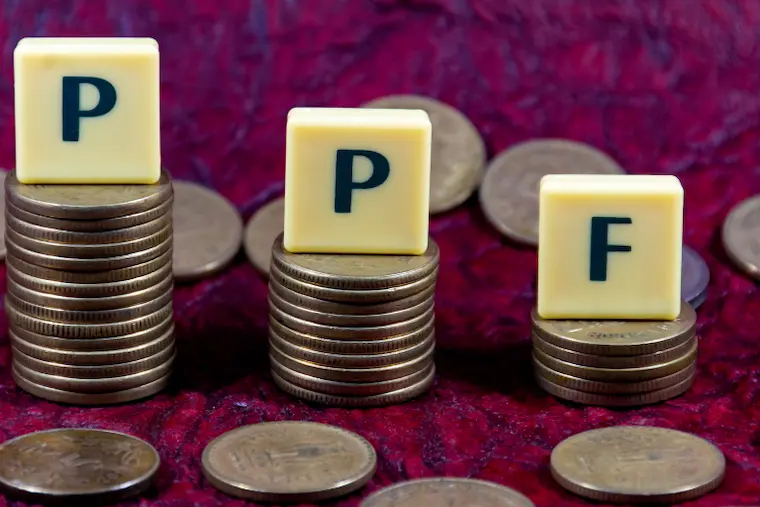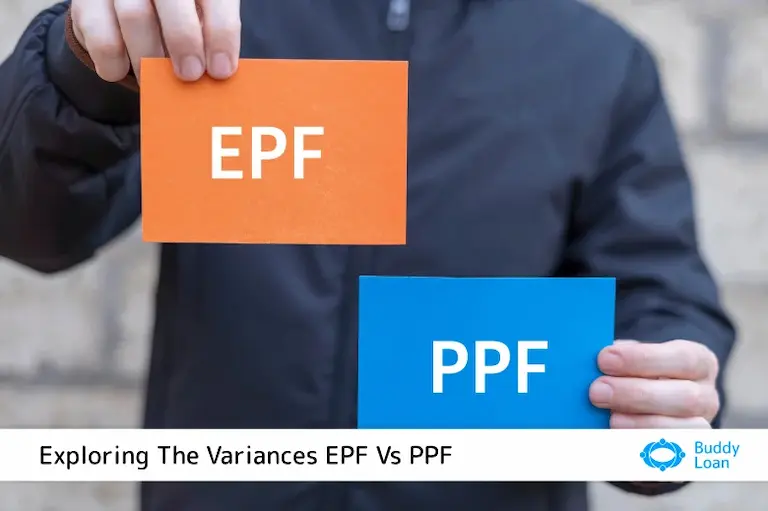The Employees’ Provident Fund (EPF) and the Public Provident Fund (PPF) are two pillars of any financial journey. These products have different functions and target different people. This blog will clarify the difference between EPF and PPF and offer a thorough comparison to enable readers to make knowledgeable decisions.
Understanding the Basics:

EPF: Strong Source of Income For Retirement Security
The Employees’ Provident Fund, established by the Employees’ Provident Fund Organisation (EPFO), is a social security initiative to ensure financial stability during an individual’s retirement years.
Additionally, with the employee and the employer contributing a predetermined percentage of the employee’s basic salary, it operates on a mandatory contribution basis.
You can also check – EPF Calculator
PPF: A Versatile Savings Option
However, the PPF has a lock-in period, meaning funds cannot be withdrawn before a certain number of years. Additionally, the interest rates on the PPF are set by the government and are subject to change. On the other hand, the PPF offers tax benefits, making it an attractive option for long-term savings.

EPF vs. PPF: A Comparative Overview:
When comparing the Employees Provident Fund and the Public Provident Fund, it’s essential to consider various factors such as eligibility, returns, and tax benefits.
Government-backed savings instruments with their own set of features:
| Feature | EPF (Employees Provident Fund) | PPF (Public Provident Fund) |
| Eligibility | Salaried individuals working in companies with 20+ employees | All Indian citizens except Hindu Undivided Families (HUFs) and Non-Resident Indians (NRIs) |
| Contribution | 12% of basic salary (equal contribution from employer and employee) | Minimum: ₹500 per year, Maximum: ₹1.5 lakh per year |
| Interest Rates | 8.50% (subject to change by government) | 7.10% (fixed by government) |
| Tax Benefits | Deductible under Section 80C of Income Tax Act (for both employee and employer contributions) | Entire investment and earned interest exempt from tax
|
| Maturity Period | Until retirement (age 58) | 15 years |
| Premature Withdrawal | Allowed for specific reasons like unemployment, medical emergencies, child’s education/marriage (partial withdrawals after 6 years) | Not allowed except in specific cases like terminal illness of self or spouse
|
| Lock-in Period | No lock-in period for employer contribution, 3 years for employee contribution | 5 years |
| Loan Facility | Available after 2 years of account opening | Available after 3 years of account opening |
| Returns | Subject to government changes | Guaranteed fixed rate, considered safe and stable |
Firstly, the choice between EPF and PPF depends on an individual’s financial goals, risk tolerance, and employment status. Additionally, it’s advisable to consult a financial advisor to determine the most suitable option based on specific circumstances.
Also Read: Differences Between NPS vs PPF
Choosing the Right Scheme
When considering the choice between EPF (Employees Provident Fund) and PPF (Public Provident Fund), it’s essential to weigh several key factors to make an informed decision that aligns with your financial goals and circumstances.
By carefully evaluating the following aspects, you can determine the most suitable provident fund scheme for your long-term financial well-being:
- Employment Status: If you are a salaried employee, EPF may be automatically deducted from your salary, while PPF is open to all Indian residents.
- Contributions and Withdrawals: Additionally, consider the eligibility criteria for each scheme. Moreover, take into account the potential tax implications. Furthermore, evaluate the risk factors associated with each scheme. Lastly, weigh the potential impact on your overall financial portfolio.
- Interest Rates and Returns: First, compare the interest rates and historical returns. Then, gauge the growth potential of your investments.
- Tax Benefit: Evaluate the tax implications of both schemes to maximize your savings and returns.
- Tenure and Maturity: Understand the tenure and maturity aspects to align with your retirement and financial planning objectives.
- Flexibility and Portability: Additionally, consider the flexibility and portability features to accommodate potential changes in employment or financial circumstances.
- Risk Factors: Assess any associated risks to make an informed decision based on your risk tolerance and investment preferences.
- Overall Financial Goals: Align the choice with your long-term financial goals, retirement planning, and wealth management strategies for optimal outcomes.
Also Read: Get Instant Access to Your PF Money with EPFO e-Wallet

Unveiling Additional Benefits:
Understanding the particular benefits offered through each plan is essential when analysing the additional benefits
1. EPF Benefits:
- Employer Contribution: EPF involves contributions from both the employee and the employer, enhancing the overall corpus for retirement.
- Pension Benefits: Additionally, EPF offers pension benefits through the Employees’ Pension Scheme (EPS), providing financial security post-retirement.
2. PPF Benefits:
- Flexible Contributions: Additionally, PPF provides the option to make contributions at different intervals, such as monthly, quarterly, or annually.
- Loan Facilities: PPF offers loan facilities against the PPF balance, providing a source of funds during financial emergencies.
Additionally, understanding these supplementary advantages can aid individuals in making well-informed decisions regarding their retirement planning and long-term financial security.
In conclusion
while both EPF and PPF serve as potent tools for financial planning, their divergent structures and intended purposes cater to different segments of the population. Additionally, individuals seeking a disciplined retirement corpus with mandatory employer participation may find the EPF more suited to their needs.
Ultimately, the choice between EPF and PPF hinges on individual financial goals, risk tolerance, and the need for liquidity. Before making a decision, consulting with a financial advisor is advised to ensure alignment with one’s overall financial strategy.
Also Read: PPF Vs LIC Which Is the Better Option
Download Personal Loan App
Get a loan instantly! Best Personal Loan App for your needs!!
Looking for an instant loan? Buddy Loan helps you get an instant loan from the best verified lenders. Download the Buddy Loan App from the Play Store or App Store and apply for a loan now!
Download the Buddy Loan app now!
Get the free Buddy Loan app on your phone
Having any queries? Do reach us at info@buddyloan.com
Frequently Asked Questions?
Q. What is the difference between EPF and PPF?
A. EPF is a mandatory retirement savings scheme for salaried individuals, while PPF is a voluntary savings scheme open to all Indian citizens.
Q. EPF vs. PPF: Which one is better for retirement savings?
A. Both are effective for retirement, but EPF, with mandatory employer contributions, is tailored specifically for salaried individuals.
Q. Can I have both EPF and PPF accounts simultaneously?
A. Yes, you can maintain both EPF and PPF accounts simultaneously.
Q. What are the eligibility criteria for EPF and PPF?
A. EPF is for salaried individuals, while PPF is open to all Indian residents, irrespective of employment status.
Q. EPF vs. PPF: Which one offers higher interest rates?
A. Interest rates vary; EPF rates are subject to market trends, while PPF rates are set by the government.
Q. Are EPF and PPF both government-backed savings schemes?
A. Yes, both EPF and PPF are government-backed savings schemes, ensuring reliability and security.
Q. Do EPF and PPF have the same maturity period?
A. No, EPF has a variable maturity period based on employment, while PPF has a fixed 15-year tenure.
Q. EPF vs. PPF: Which is better for long-term financial goals?
A. Both are suitable for long-term goals, but EPF may be preferable for those with stable employment.
Q. What happens to my EPF and PPF accounts if I change jobs?
A. Your EPF account remains active; however, you can transfer or continue it with the new employer. Additionally, PPF remains unaffected.
Q. How can I check the balance in my EPF and PPF accounts?
A. In addition, EPF balance can be checked through the EPFO portal, and PPF balance can be verified at the bank or post office where the account is held.
Q. Are there any penalties for premature withdrawals from EPF and PPF?
A. EPF may incur penalties for premature withdrawals, while PPF allows partial withdrawals from the 7th year onwards.
Q. Can I take a loan against my EPF and PPF balances?
A. EPF allows loans for specific purposes, while PPF permits partial withdrawals for specific needs.
Q. EPF vs. PPF: Which one is more suitable for tax-saving purposes?
A. Both EPF and PPF offer tax benefits, but PPF is renowned for its tax-efficient savings under Section 80C.




